What Should I Alternate With Strawberries In My Garden
Strawberries are so delicious that they not only work magic with our taste buds but also attract common pests and small predators.
If you happen to find deep holes in fruits, misshapen fruiting, premature blossoms, or stunted growth, you should know the nasty strawberry pests have already taken over.
The infestation of regular garden pests like slugs, beetles, clippers, and small animals like birds and raccoons will likely cause strawberry damages, including stunted blossoms, premature decay, and tiny holes in the fruits.

While most pests feast on the fruiting, some enjoy infesting the young bugs to reproduce and lay eggs.
Therefore, you should start with understanding different kinds of pests prevalent in the garden to find a reliable treatment and prevention.
Here is a guide to help you identify these pests and ways to remove them effectively.
Is Pest Common in Strawberries?
Pest infestation is more common in strawberry bushes than you can imagine.
Like any fruit-bearing plant, they are susceptible to pests around the year.
Over 200 species of arthropod pests are reported on strawberries in the U.S. (Schaefers 1981). However, only about 15 species of these pests are considered a concern to strawberry producers.
Therefore, your strawberry bushes will likely attract harmful pests and small animals around the year.
The crawling bugs, small insects, and birds are attracted to the characteristic aroma, rich red color, juicy texture, and sweetness of the ripe fruit.
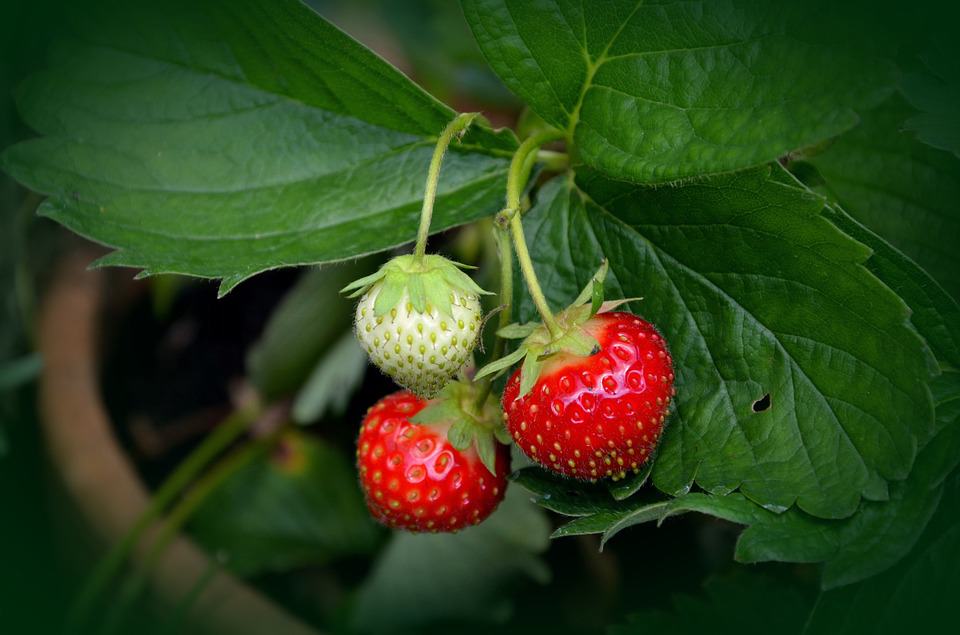
Some are attracted to its foliage, new fruit buds, and new blossoms. A few may infest the plant solely for overwintering.
The initial pest infestation occurs during early spring when Bud Weevils and Tarnished Bug emerge from overwintering and start infesting the new fruit buds to lay their eggs primarily.
Spittlebug larva may infest strawberries to seek shelter and grow inside the fruits before coming out in the spring.
Most pests and small animals will invade the plant when it begins to ripen in May and June, which becomes evident with fruit damages such as tiny holes, bite marks, and decay.
Most gardeners are likely to confuse browning and yellowing foliage, stunted growth, leaf spots, or premature fruit dropping with possible pest problems.
However, you should match these problems with the signs of overwatering problems before concluding on the pest problems.
What is Eating my Strawberries?
Despite providing an appropriate growing condition, the tell-tale signs of fruit damages indicate only one thing -pests.
Different pests are attracted to strawberries on different stages, leaving visible damages. Therefore, you can quickly identify the pest infestation by assessing the damages.
Therefore, we have compiled a list of pests prevalent in strawberries and their damages, along with ways to treat and prevent them.
1. Tarnished Plant Bugs
Tarnished plant bug is a deadly pest that injects a toxic substance that breaks down the plant tissues, causing significant damages.
The Tarnished bug's toxin kills plant cells near the feeding site, causing distorted growth surrounding their sting marks.
Moreover, these bugs are primarily associated with catfacing injury. This distorted fruit shape looks like puckered cheeks of a cat caused by their piercing-sucking mouthparts that can easily do a lot of damage.

There are many varieties of tarnished plant bugs; hence, you should look for those that primarily feast on strawberries.
The adult bugs are 1/4 inch in size with wings. They display a brassy or tarnished body-color with yellow or bronze marks. Each forewing has a black tip with a yellow triangle.
The adult females emerge in spring to lay eggs that hatch into nymphs—the eggs hatch in about 5 to 7 days.
The nymphs will feed on blossoms and fresh strawberry seedlings, causing misshapen fruit and fruit discoloring.
You could identify their presence by their yellowish-green body and miniature 1 mm size.
Treatment for Tarnished Plant Bug
- Start with disposing of the damaged fruits as they can transmit decay to other fruits in the bush.
- Apply an appropriate pesticide (Containing Pyrethrum, Captan, and Malathion) to kill active tarnished bugs without killing beneficial insects.
- Spray the plant with an appropriate insecticide once in two weeks to kill immature nymphs.
- Encourage beneficial insects like big-eyed bugs, damsel bugs, and pirate bugs into your garden.
- Use a white sticky trap around the garden to trap and kill active adult bugs.
Preventive Measures
- Spraying garlic around the plant before and during spring will deter bugs from laying eggs.
- Mow the grass and weeds around the garden to eliminate hide-spots and breeding ground.
- Use floating row cover after planting to protect the new foliage from pests.
- Alternatively, plant pollen-producing flowers around the garden that attract beneficial insects.
2. Slugs
Slugs are similar to snails but without a shell.
These slimy bugs infest strawberries by penetrating the fruiting, rendering them unproductive. Next, they infest ripened fruits and green foliage, then produce visible holes.
They become active during the rainy season and may come out at night. In a few cases, significantly wet soil may also attract slimes.

An early way to notice slugs is by their trail of slime left around the leaves and soil.
Once you see slugs around your plant, check for their eggs that are generally laid under debris.
You would know slugs eggs when you identify tiny, round, jelly-like ovules.

Treatment for Slugs
- For starters, you can handpick the slugs and drop them in a pan of beer or cover them with salt.
- Apply commercial slug baits to capture slugs effectively. (The baits contain iron phosphate or metaldehyde that attracts iron-consuming slugs) Once trapped, they become less mobile and die within a few days.
- Use SLUGGO, an iron phosphate bait containing an organic compound that attracts the slugs without damaging the wildlife.
- As an option, you can mix Methiocarb (Mesurol 75-W) with water and spray over the plant to kill and repel slugs.
- Alternatively, you can apply a homemade treatment of bleach mixed with water to kill slug eggs or pour a mild solution of soapy and salty water over the soil to kill slug eggs.
Preventive Measures
- Remove dead leaves and debris from the area to eliminate their hide spots.
- Alternatively, you can use a copper barrier to wrap it around the growing bench to repel the slugs.
- Water your strawberry bushes appropriately. Overtly wetting the soil will encourage damp soil conditions.
- Use citrus rind traps of oranges, lemon, or lime around the base of the plant to attract slugs. Once they gather up, you can pick them up and drop them in a soapy salt solution.
- If you wish to use natural control, consider introducing hedgehogs, beneficial beetles, frogs, and toads into your garden.
- Sprinkle diatomaceous earth, a powdery, granular material, around garden beds to repel the slugs.
3. Strawberry Clippers
Strawberry clippers, also known as strawberry bud weevils, are brown beetles.
They are hardly 1/4 inches long, and you could identify them by their weevil "snout" and reddish-brown body.
The overwintered beetles become active in spring and start feeding on young buds, causing blossom drop-off.
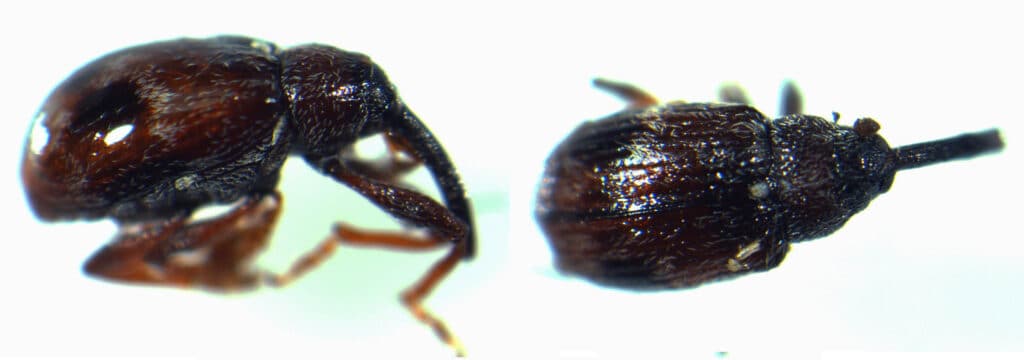
An adult beetle will chew through the pedicel to lay eggs. Once the eggs are hatched after a week, the larva will start feeding for 3-4 weeks.
There is only one annual generation of strawberry clippers, and they will overwinter before becoming active again next year.
Treatment for Strawberry Clippers
- Start with removing and disposing of infested fruits.
- Apply insecticidal soap appropriate for a strawberry clipper that will effectively eliminate the beetles.
Preventive Measures
- Pesticide can effectively reduce the population of beetles, but beware about applying it during spring and daytime when the bees are foraging.
- Apply the first spray in early May and the second spray ten days later.
- Cropping fields less than three years, plowing under the bed after harvest, and removing old mulch will help to reduce the breeding site.
Note: So far, none of the organic treatment has been proved effective against strawberry clippers.
4. Spittlebugs
Spittlebugs are nasty pests that suck fluids from the xylem of the strawberry plants and spread Xylella, a pathogen that invites stunting, wilting, discoloration, and shriveled fruit.
However, not all spittlebugs spread Xylella. Most of them are harmless but still annoying for the gardeners.
These insects are most active in spring and lay eggs from July through October, where the larva hatches in a week or two and start feeding on the tender foliage.
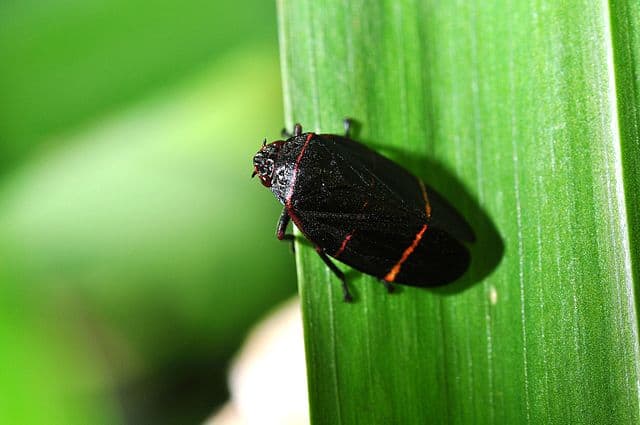
You could recognize spittlebug infestation by the white foam-like substance on leaves, petioles, and stems.
The spittlebug larva grows to become froghoppers that can jump many times their height.
Check every two weeks for spittlebug foam and nymphs at the base of the plants. Otherwise, look for nymphs with large red eyes and soft, elongated bodies up to 1/4 inch long.
You can quickly identify them with their body color that changes from orange to yellow and brown as they grow.
Treatment for Spittlebug Infestation
- For a small infestation, consider blasting them off with a water hose, which will disrupt their activities.
- Both Neem oil and citrus-based pesticides are effective in reducing their number.
- Alternatively, use a homemade spray of garlic or hot pepper mixed with water to kill the insects instantly.
- Eastern meadowlark birds are the natural spittlebug predator and effective biological control, but they are only found in east coast regions.
However, controlling a more significant infestation may not be possible with any homemade treatment.
Note: Spray the plant with a broad-spectrum insecticide containing acetamiprid, carbaryl, chlorpyrifos, fenpropathrin, or malathion.
Preventive Measures
- Remove mulch, old and dead leaves, and overgrown grasses around the area at the end of the growing season to prevent the bugs from overwintering.
- Cover the bushes with floating row covers in summer to prevent adult insects from laying their eggs.
- Trim your lawn in the fall and winter for broadleaf weeds that host overwintering spittlebugs.
5. Strawberry Sap Beetles
Sap beetles are pretty common in strawberry bushes around summer when the fruit is ripening.
Cracked or damaged fruits and any injury exposing plant sap that can ferment will also attract sap beetles.
They primarily feed on ripening fruit, but they prefer soft, overripe, or rotting fruits, causing significant damage.
They leave deep cavities in the fruit, similar to the damage caused by slugs, and introduce fungi of organisms that can further spoil the fruit.
They lay eggs in debris near rotting fruit, and the larvae will primarily feed inside the fruit then pupate in the soil nearby their food source.

The worst thing about sap beetle is that they help spread rot-causing disease organisms from one plant to another.
One way to identify sap beetle infestation is through the damages such as small holes at the bottom of the fruit or a large section eaten from the side.
Otherwise, try looking for black or dark bugs with a flattened and broadly oval body and four yellowish spots on the wings.
Females lay about 5 to 15 eggs per day and around 300 to 400 eggs in their lifetime.
Treatment for Strawberry Sap Beetle
- Start with identifying and disposing of damaged strawberries as these become the host for the pest.
- Use sap beetle trap to capture the pests outside the fields before they invade the crops.
- Use alternative baits like plastic funnel traps with vinegar, molasses, and water to capture and drown the pests.
- You can also use a container filled with stale beer and water with yeast to attract, capture, and drown the pests.
- As a biological control, use beneficial nematodes that seek out and kill over 200 pests in the soil.
Note: Using sap beetle insecticide (Carbaryl and bifenthrin) can effectively control severe infestations, but it may also damage the ripe fruits. Therefore, opt for other methods before resorting to the insecticide.
Preventive Measures
- Harvest the fruit before they become overripe to prevent attracting the pests.
- Dispose of the fallen fruit from the ground. However, avoid disposing of them in weeded areas as sap beetles often lurk in excessive weed and grassy areas.
- Clear the weed and tall grass around the garden before growing your strawberries and during the fall before the pests go into overwintering.
6. Two-spotted Spider Mite
The two-spotted spider mite is a deadly strawberry pest that seriously weakens the plant before overwintering.
Therefore, the weakened plant is less likely to survive the winter or produce quality yields the following year.
It is a yellowish bug about 1/50 inch long with a brown or orange-red body and is usually found on leaf undersides.
The feeding is particularly damaging during the first 2 to 5 months following transplanting in late summer or fall, causing a substantial yield reduction.
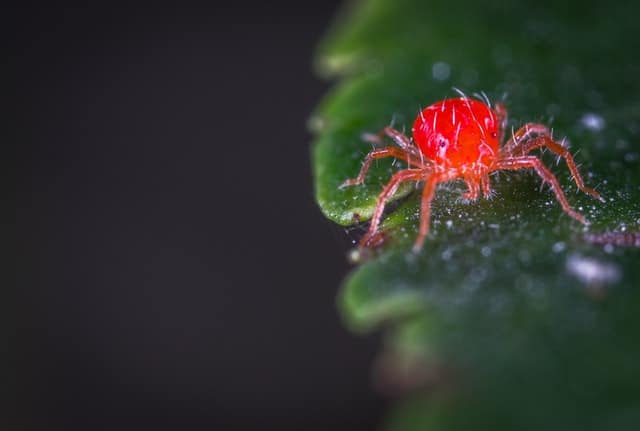
A female spider mite can lay up to 200 eggs that will start hatching in not more than seven days. The plant will start wilting once the larvae begin feeding.
15-20 spider mites per leaflet can cause substantial fruit damages.
However, the severe infestation may only begin when their number starts proliferating.
Plants that see over 75 mites per leaflet may become severely weakened and appear stunted, dry, and turn red.
The most effective way to identify spider mite infestation is to check the under leaves for silk webbings. They lay eggs covered with fine silk webbing to protect them from predators.

Otherwise, look out for slight yellowish-white flecking visible on the upper leaf surface.
Treatment for Two-Spotted Spider Mite
- Spray the infected plant with a miticide (pesticide specific to spider mites) every seven days until the infestation is removed.
- Spraying the plant with Neem oil spray will also work effectively. However, avoid using insecticides or pesticides to kill spider mites as they can kill other beneficial bugs too.
- Alternatively, to ensure multi-year spider mite control, use a biological control of releasing predatory mites, Neoseiulus californicus and Neoseiulus fallacies.
Preventive Measures
- Resort to a biological method of planting companion plants like Chinese parsley, chives, dill, chrysanthemums, and garlic to repel spider mites.
- Placing insect traps on the base of the plant to capture spider mites works effectively.
- Try maintaining the general hygiene of the plant by regular monitoring and killing individual bugs to avoid spider mite infestation.
- Pre-plant cooling or vernalization method of production may help prevent spider mite infestation by keeping the garden cool at all times.
7. Spotted Wing Drosophila (Small Fruit Fly)
If you are active on the smartphone app TikTok, you must have seen growers washing strawberries in warm salt water to expel tiny, white larvae from the fruit.
These are tiny fruit flies' larvae hatched from eggs inside the strawberries by adult small fruit flies.
Spotted wing drosophila, better known as the tiny fruit fly, is a common pest found in strawberries and other juicy fruits.
They primarily feed on overripe fruits, hatching their eggs inside that soon turn into larvae.

They can lay about 500 eggs at a time, which will hatch within a week. Therefore, harvesting your yields before they become overripe becomes a must.
Treatment for Small Fruit Fly
- Avoid using pesticides to control fruit flies as they severely damage good yields.
- Mix 1/2 teaspoon of liquid soap with 1 cup lukewarm water in a sprayer, and spray it over the flies. Next, wipe the plant off the flies using a soft cloth.
- Spraying 90% isopropyl alcohol diluted with water will also be effective in killing these pests.
- Try using sticky traps to catch the flies as bait.
Preventive Measures
- Harvest the fruit immediately upon they ripen to prevent attracting small fruit flies.
- Eliminate food sources such as damaged or disposable fruits from the garden to prevent attracting fruit flies.
- Alternatively, fill a few bowls with 1/2 cup cider vinegar and two teaspoon dish soap and keep them around the plant to attract the flies into the bowls.
8. Strawberry Rootworm
Strawberry rootworm (Paria fragariae) is a beetle that is typically found in perennial strawberry production.
Adult beetles emerge in mid-spring after overwintering and remain active until early summer.
They become more prevalent in May and again in July, especially at night.
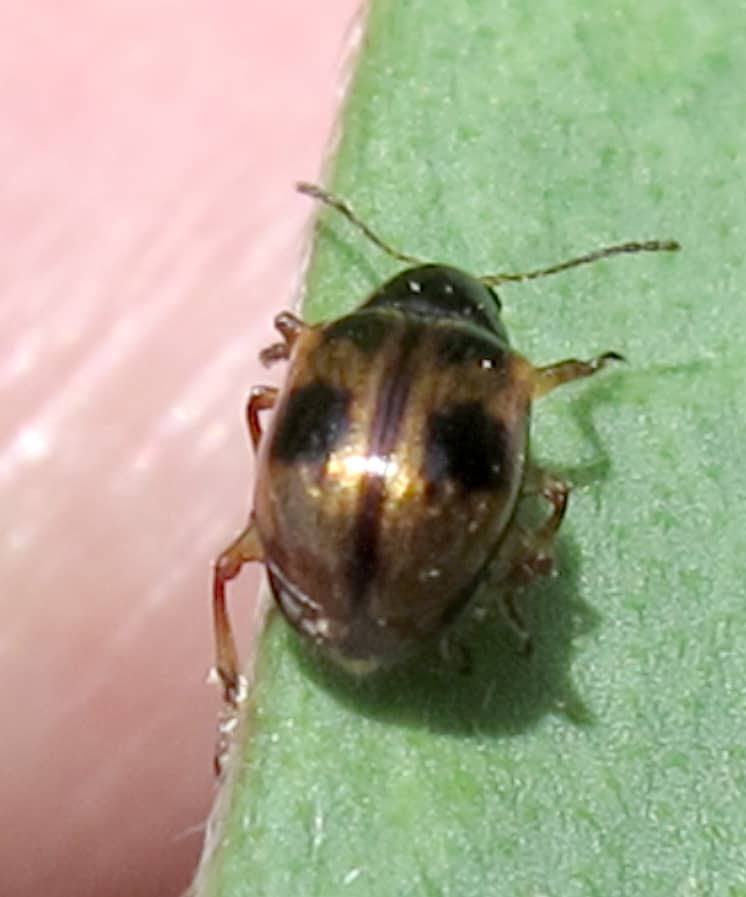
They would feed on leaves, leaving tiny holes, while larvae or grubs would feed on roots. In either case, it will cause the plant to lose its vigor.
You can identify this pest by dark and oval-shaped body approximately 3 mm long, while larvae are white-colored.
They will lay eggs in fruit as ripening begins during summer. Check for small holes in the berries where they lay eggs.
Treatment for Strawberry Rootworm
- Use a biological control PFR-97 20% WDG, a microbial insecticide containing fungus that will eat on strawberry rootworm and other pests.
- Alternatively, use appropriate insecticides to treat strawberry rootworms. Use the manufacturer's guidelines before applying.
Preventive Measures
- Start with pruning weeds and grass around the garden to increase sunlight and reduce humidity. The rootworm is more prevalent in humid conditions.
- Allow the ground and mulch surface to dry before rinsing. Treat problem areas where water puddles are slow to dry out.
- Pre-plant cooling or vernalization method of production may help prevent rootworm infestation by keeping the garden cool (32° – 33° F) at all times.
Additional Info
Some rarely seen yet prevalent strawberry pests include Eastern Flower Thrips, cockroaches, and ants.
Especially, cockroaches and ants eat deep into strawberries, leaving a cavity.
Flower thrips would feed on both leaves and fruits, leaving brown and withered stigma and anthers,
- You can easily remove roaches and ants by sprinkling diatomaceous earth around your strawberries to repel the pests.
- Alternatively, welcoming biological control like pest-eating birds will also help control these pest populations.
- Consider using a yellow sticky strap as bait or pyrethrin spray to repel the pests for flower thrips.
9. Small Birds
Not only pests but also birds love feasting on strawberries that may significantly reduce your yield.
Small birds like Robin, Crows, Blue Jays, Finches, and Orioles are the major predatory birds that primarily feast on ripe strawberries.

From picking the whole fruit to nibbling on them, birds can damage a large amount of fruit in a short time.
You would mostly see these birds invading your garden in summer when the fruit is ripe.
However, applying a deterrent does not mean killing or injuring the birds. Several physical deterrents work well without harming the birds.
How to Deter Small Birds
- Cover the bushes with 1-inch hole chicken wire to deter the birds.
- Using mesh or butterfly netting over the bushes may also work with deterring the birds.
- As a temporary solution, install fake snakes and predator toys in the garden to scare away the birds.
- Installing a scarecrow to scare away the birds may also work.
10. Furry Animals
You may also find small furry animals in your garden that steal away your yields and damage the bushes.
The burrowing animals like squirrels, raccoons, and rabbits are excellent climbers that will climb the trays to reach the plants.

Once close to the plant, they will eat away the young and ripe fruits, leaving only debris.
You should start with physical control methods to aver them before they become a severe threat.
How to Deter Furry Animals
- Install a chicken wire fence at least 30 inches high, buried 6 inches deep, to repel the small animals like raccoons and rabbits without harming them.
- Alternatively, you can apply the small animal repellant spray to keep them away to some extent.
Quick Tip: Consider placing blood meal, feather meal, human hair, and commercial deer repellants near the plant to deter big animals like deer.
Conclusion
Different pests will eventually invade your garden when you are trying to grow a fruit-bearing plant-like strawberry.
However, you can easily avoid this common annoyance by taking proper precautions and improving the growing conditions.
The deterrent methods may also work well to keep the small animals and birds at bay.
If nothing seems to work, you can always use the appropriate chemical, organic, or biological treatments mentioned above in this guide.
What Should I Alternate With Strawberries In My Garden
Source: https://plantscraze.com/what-is-eating-my-strawberries/
Posted by: smithbanke1953.blogspot.com

0 Response to "What Should I Alternate With Strawberries In My Garden"
Post a Comment